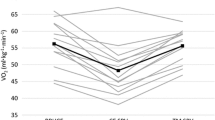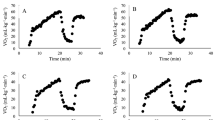Abstract
Introduction
A customized submaximal exercise test for cycle ergometry was reported as a superior estimate of maximum oxygen uptake (VO2max) in comparison to the traditional YMCA ergometry test.
Purpose
Following similar methodology, we sought to validate a customized submaximal treadmill test (CustomTM) compared with the widely used Bruce submaximal protocol.
Methods
Participants (29 women and 21 men; age = 31.37 ± 11.44 year, BMI = 24.02 ± 3.03) performed a graded exercise test (GXT) with a subsequent exhaustive, square-wave bout for the verification of “true” VO2max. In counterbalanced order, subjects then completed submaximal protocols. The CustomTM protocol consisted of two 3-min stages estimated at 35 and 70% of VO2max, where VO2max was estimated with a linear regression equation utilizing sex, BMI, age, and self-reported physical activity.
Results
VO2 values from the GXT and verification bout were 47.2 ± 7.7 and 47.0 ± 7.7 ml kg−1 min−1, respectively (ICC = 0.99, CV = 2.0%, TE = 0.83 ml kg−1 min−1), with the highest value used as “true” VO2max (47.7 ± 7.7 ml kg−1 min−1). Neither the Bruce (45.95 ± 6.97 ml kg−1 min−1) nor the CustomTM (47.3 ± 9.4 ml kg−1 min−1) protocol differed from “true” VO2max. The CustomTM had a “very large” measurement agreement with “true” VO2max (ICC = 0.78, CV of 9.1%, TE = 4.07 ml kg−1 min−1). Bruce had a “large” measurement agreement with “true” VO2max (ICC = 0.62, CV of 10.0%, TE = 4.51 ml kg−1 min−1).
Conclusion
The CustomTM was superior to the Bruce protocol, because it included a stage below and above gas exchange threshold, yielded a better measurement agreement for “true” VO2max, and was more time efficient.




Similar content being viewed by others
References
American College of Sports Medicine (2018) ACSM’s guidelines for exercise testing and prescription. 10th edn. Lippicott, Williams, & Wilkins, Baltimore
Astrand PO, Ryhming I (1954) A nomogram for calculation of aerobic capacity (physical fitness) from pulse rate during submaximal work. J Appl Physiol 7:218–221
Beaver WL, Wasserman K, Whipp BJ (1986) A new method for detecting anaerobic threshold by gas exchange. J Appl Physiol 60(6):2020–2027
Bjorkman F, Ekblom-Bak E, Ekblom O, Ekblom B (2016) Validity of the revised Ekblom Bak cycle ergometer test in adults. Eur J Appl Physiol 116(9):1627–1638
Blair SN, Kampert JB, Kohl HW 3rd, Barlow CE, Macera CA, Paffenbarger RS Jr, Gibbons LW (1996) Influences of cardiorespiratory fitness and other precursors on cardiovascular disease and all-cause mortality in men and women. JAMA 276(3):205–210
Bland JM, Altman DG (1986) Statistical methods for assessing agreement between two methods of clinical measurement. Lancet 1(8476):307–310
Bruce RA, Kusumi F, Hosmer D (1973) Maximal oxygen intake and nomographic assessment of functional aerobic impairment in cardiovascular disease. Am Heart J 85(4):546–562
Dabney U, Butler M (2006) The predictive ability of the YMCA test and Bruce test for triathletes of different training backgrounds. Emporia State Res Stud 43:38–44
Farrell SW, Fitzgerald SJ, McAuley PA, Barlow CE (2010) Cardiorespiratory fitness, adiposity, and all-cause mortality in women. Med Sci Sports Exerc 42(11):2006–2012
Fitchett MA (1985) Predictability of VO2max from submaximal cycle ergometer and bench stepping tests. Br J Sports Med 19(2):85–88
Foster C, Porcari JP, Anderson J, Paulson M, Smaczny D, Webber H, Doberstein ST, Udermann B (2008) The talk test as a marker of exercise training intensity. J Cardiopulmon Rehabil Prevent 28(1):24–30
Gaesser GA, Poole DC (1996) The slow component of oxygen uptake kinetics in humans. Exerc Sport Sci Rev 24:35–71
Golding LA, Sinning WE, Myers CR (1989) Y’s way to physical fitness: the complete guide to fitness testing and instruction, 3rd edn. Human Kinetics, Champaign
Hopkins WG (2000) Measures of reliability in sports medicine and science. Sports Med 30(1):1–15
Jackson AS, Blair SN, Mahar MT, Wier LT, Ross RM, Stutesville JE (1990) Prediction of functional aerobic capacity without exercise testing. Med Sci Sports Exerc 22:863–870
Jamnick NA, By S, Pettitt CD, Pettitt RW (2016) Comparison of the YMCA and a custom submaximal exercise test for determining VO2max. Med Sci Sports Exerc 48:254–259
Kirkeberg JM, Dalleck LC, Kamphoff CS, Pettitt RW (2011) Validity of 3 protocols for verifying VO2max. Int J Sports Med 32:266–270
Lee DC, Sui X, Artero EG, Lee IM, Church TS, McAuley PA, Stanford FC, Kohl HW 3rd, Blair SN (2011) Long-term effects of changes in cardiorespiratory fitness and body mass index on all-cause and cardiovascular disease mortality in men: the Aerobics Center Longitudinal Study. Circulation 124:2483
Londeree BR, Moffitt-Gerstenberger J, Padfield JA, Lottmann D (1997) Oxygen consumption of cycle ergometry is nonlinearly related to work rate and pedal rate. Med Sci Sports Exerc 29(6):775–780
Midgley AW, McNaughton LR, Polman R, Marchant D (2007) Criteria for determination of maximal oxygen uptake: a brief critique and recommendations for future research. Sports Med 37(12):1019–1028
Pettitt RW, Symons JD, Taylor JE, Eisenman PE, White AT (2008) Adjustment for gas exchange threshold enhances precision of heart rate-derived VO2 estimates during heavy exercise. Appl Physiol Nutr Metab 33:68–74
Pettitt RW, Jamnick N, Clark IE (2012) 3-min all-out exercise test for running. Int J Sports Med 33:426–431
Pettitt RW, Clark IE, Ebner SM, Sedgeman DT, Murray SR (2013) Gas exchange threshold and VO2max testing for athletes: an update. J Strength Cond Res 27:549–555
Riebe D, Franklin BA, Thompson PD, Garber CE, Whitfield GP, Magal M, Pescatello LS (2015) Updating ACSM’s recommendations for exercise preparticipation health screening. Med Sci Sports Exerc 47(11):2473–2479
Sietsema KE, Daly JA, Wasserman K (1989) Early dynamics of O2 uptake and heart rate as affected by exercise work rate. J Appl Physiol 67(6):2535–2541
Tanaka H, Monahan KD, Seals DR (2001) Age-predicted maximal heart rate revisited. J Am Coll Cardiol 37(1):153–156
Zoladz JA, Rademaker AC, Sargeant AJ (1995) Non-linear relationship between O2 uptake and power output at high intensities of exercise in humans. J Physiol 488(Pt 1):211–217
Zoladz JA, Duda K, Majerczak J (1998a) Oxygen uptake does not increase linearly at high power outputs during incremental exercise test in humans. Eur J Appl Physiol Occup Physiol 77(5):445–451
Zoladz JA, Szkutnik Z, Majerczak J, Duda K (1998b) Detection of the change point in oxygen uptake during an incremental exercise test using recursive residuals: relationship to the plasma lactate accumulation and blood acid base balance. Eur J Appl Physiol Occup Physiol 78(4):369–377
Funding
No external funding was provided for this study.
Author information
Authors and Affiliations
Contributions
CS, RP, LK, NJ, CH, and CP conceived and designed the research, collected the data, analyzed the data, and wrote the manuscript. All authors read and approved the manuscript.
Corresponding author
Ethics declarations
Conflict of interest
The authors declare that they have no conflict of interest.
Additional information
Communicated by Jean-René Lacour.
Rights and permissions
About this article
Cite this article
Strom, C.J., Pettitt, R.W., Krynski, L.M. et al. Validity of a customized submaximal treadmill protocol for determining VO2max. Eur J Appl Physiol 118, 1781–1787 (2018). https://doi.org/10.1007/s00421-018-3908-x
Received:
Accepted:
Published:
Issue Date:
DOI: https://doi.org/10.1007/s00421-018-3908-x




